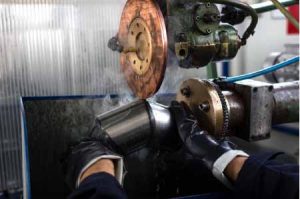 Almost every maintenance shop has a bench or pedestal grinder. These are powerful, useful tools, but they are also potentially dangerous because users take them for granted.
Almost every maintenance shop has a bench or pedestal grinder. These are powerful, useful tools, but they are also potentially dangerous because users take them for granted.
About 3,200 people nationwide received hospital treatment for workshop grinder, buffer, and polisher injuries during 2016. Serious injury and even death can result from improper handling, installation, or use of abrasive wheels. Cracked or defective grinding wheels can “explode” when in use.
Proper Hazard Guarding
The wheel guard enclosure should cover most of the wheel, the spindle, and the wheel mounting hardware. Some of the wheel must be exposed to allow grinding access, but the maximum access space between the horizontal work rest and the top of the wheel guard opening should be no more than 65 degrees of the wheel.
The horizontal work rest should be adjusted to within 1/8-inch of the wheel. This reduces the risk of wheel breakage caused by an item being jammed between the work rest and the wheel.
The tongue guard is an adjustable safety plate that is attached at the top of the wheel guard enclosure and can be moved closer to the wheel as its diameter decreases from wear. The distance between the tongue guard and the wheel must not exceed 1/4-inch in order to minimize exposure to flying fragments in the event of wheel disintegration.
A transparent hinge-mounted face guard should be attached over the exposed wheel surface area to provide additional protection from particles thrown off the rapidly spinning disk.
Personal protective equipment includes safety glasses and a face shield–your face as well as your eyes need protection.
WHERE DANGER LINGERS…WATCH YOUR FINGERS!!
Download flyer: STOTW_1245_Bench_Grinder_Safety Download Spanish flyer: STOTW_1245_Bench_Grinder_Safety_esp

